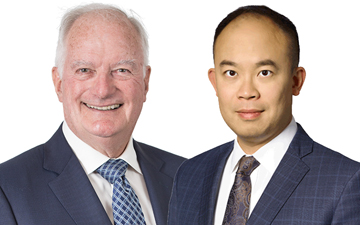Our response to the CRA's position on creditor-proofing reorganizations – part 2 (a case study)

A three-part series from Doug S. Ewens and Kenneth Keung of Moodys Tax Law
Editor's Note: The following is part two of a three-part series. Click on the links at the bottom to read the entire series in order.
In this post, we build upon our Response to the CRA's Position on Creditor-Proofing Reorganizations blog by presenting a specific example of a creditor-proofing reorganization.
Assume that Mr. A owns all of the outstanding shares of a holding corporation ("H-1") which, in turn, owns all of the outstanding shares of an operating corporation ("Opco") which, in addition to operating assets, also has considerable cash exceeding the amount required for use in its business and investments in marketable securities. Importantly, none of Mr. A, Opco or H-1 has any plan to sell to any unrelated person, in the foreseeable future, any shares in the capital of either Opco or the new holding subsidiary to be incorporated by H-1 that will be called "H-2", or to permit any unrelated person to subscribe for or otherwise acquire any shares of any of H-1, Opco or H-2.
Proposed Transactions
This creditor-proofing reorganization has two aspects. The first is to isolate the non-business assets such as the excess cash and investments in marketable securities presently owned by Opco into H-2, the newly incorporated subsidiary of H-1 and sister of Opco. The second aspect is to cause Opco to purchase for cancellation most of its outstanding common shares owned by H-1 in exchange for the issuance by Opco to H-1 of a secured debenture having a fair market value equal to the fair market value of the outstanding shares of Opco being so purchased, for the sole purpose of protecting the entire present value of Opco from potential future claims of its creditors.
Step 1 – Isolating all Non-Business Assets of Opco in H-2
- Formation by H-1 of New Holding Corporation H-2
H-1 incorporates new subsidiary holding corporation H-2, the authorized capital of which includes Class A voting common shares and Class B non-voting special shares carrying the right of the holder to receive a preferential cumulative annual dividend at a fair market dividend rate (eg. 5.0 % per year of the value of the property received by H-2 in consideration of the issuance of the Class B special shares). We recommend that the advice of a professional business valuator be obtained in selecting the fair market dividend rate, in light of the specific circumstances.
H-1 subscribes $1,000.00 for 1,000 voting common shares in the capital of H-2.
1.2 Opco Transfers Excess Cash and Investments to H-2
Opco transfers to H-2 its excess cash and all of its investments in consideration of the issuance by H-2 to Opco of:
- 10,000 Class B non-voting special shares having the attributes described in paragraph 1.1 above; and
- a covenant by H-2 to make a joint election with Opco to have the provisions of subsection 85(1) apply to the transfer of the investments.
The intent of structuring this transfer is to avoid triggering any tax on the capital gain accrued in the investments in marketable securities owned by Opco, by having Opco and H-2 make a joint election under subsection 85(1) of the Act. If no substantial amount of gain has accrued in such investments, then the incorporation of H-2 and this step could be omitted.
The purpose of causing the Class B non-voting special shares to carry a preferential cumulative annual dividend at a fair market dividend rate is to ensure to the extent possible that their fair market value is equal to the total value of the excess cash and marketable securities that are transferred by Opco to H-2 (so as to provide evidence that there exists no intention that this transfer include any amount of benefit conferred by Opco on H-1 for purposes of paragraph 85(1)(e.2) of the Act). Normally this objective is achieved by having a transferee corporation issue to the transferor corporation retractable preferred shares having a redemption amount equal to the value of the property being transferred; however, that should not be done in a creditor-proofing reorganization because if creditors of Opco were to assert a large enough claim, they could recover potentially all property then owned by Opco. If the property of Opco were to include retractable preferred shares of H-2, then those creditors would be entitled to exercise their retraction rights and thereby acquire all of the cash and investment assets then owned by H-2. By instead having H-2 issue to Opco non-voting special shares, creditors that assert substantial claims against Opco could not acquire the cash or investment assets then owned by H-2 but would be entitled only to receive dividend income on their Class B non-voting special shares of H-2 at the aforementioned fair market dividend rate.
Step 2 – H-1 Exchanges most of its Equity Investment in Opco for a Secured Debenture
2.1 Purchase for Cancellation of a portion of Opco's Outstanding Common Shares
Opco purchases for cancellation from H-1 at fair market value most of its outstanding common shares (eg. 99% thereof) and satisfies the purchase price by issuing to H-1 a debenture having a principal amount equal to the fair market value of the purchased shares of Opco and providing the holder with a first fixed charge over all fixed assets then owned by Opco (including the Class B non-voting special shares of H-2), as well as a floating charge over all other assets then owned by Holdco (i.e. a general security agreement). Some common shares of Opco (eg. 1% of the number previously outstanding) will continue to be owned by H-1, as a result of which Opco will continue to be a wholly owned subsidiary of H-1. The purpose of this step is to achieve creditor proofing for H-1 to the extent of substantially all of its investment in Opco, thereby entitling H-1 to rank ahead of all unsecured creditors of Opco to the extent of the full amount of H-1's entire existing investment in Opco.
Summary Analysis
The following is a summary of our views as to the principal Canadian federal income tax considerations relevant to the Proposed Transactions.
Step 1: This step should result in a tax-deferred rollover being obtained for Opco's transfer to H-2 of its marketable securities, thereby deferring taxation on any accrued gain inherent in those securities. This result assumes that Opco and H-2 will jointly file an election under subsection 85(1) of the Act in prescribed form and within the prescribed time stipulating that the elected amount in respect of each security being transferred be equal to the adjusted cost base thereof to Opco immediately before the transfer occurs.
Step 2: Subsection 84(3) should apply to the purchase for cancellation by Opco of most of its outstanding common shares held by H-1 such that Opco is deemed to pay, and H-1 is deemed to receive, a taxable dividend equal to the amount by which the purchase price paid for those common shares exceeds their paid-up capital. H-1 should be entitled to a deduction under subsection 112(1) equal to the full amount of that deemed dividend. Subsection 55(2) should not apply to recharacterize that deemed dividend as a capital gain for the reason that paragraph 55(3)(a) specifically provides that subsection 55(2) "does not apply" to "any" dividend received by a corporation (referred to therein as the "dividend recipient") on a redemption, acquisition or cancellation of a share by the corporation that issued that share (referred to therein as the "dividend payer"), to which subsection 84(2) or (3) applies if, as part of the transaction or event or series of transactions or events as a part of which the dividend is received, there was not at any particular time one of the following "triggering events":
- a disposition of property to a person or partnership that was an unrelated person immediately before the particular time;
- a significant increase in the total direct interest in any corporation of one or more persons or partnerships that were unrelated persons immediately before the particular time;
- a disposition to a person or partnership that was an unrelated person immediately before the particular time of shares of the dividend payer or property more than 10% of the fair market value of which was derived from a combination of shares and/or debt of the dividend payer; or
- after the time the dividend was received, a disposition to a person or partnership that was an unrelated person immediately before that particular time of shares of the dividend recipient or property more than 10% of the fair market value of which was derived from a combination of shares and/or debt of the dividend recipient.
In our view, for the reasons discussed in more detail in our Response to the CRA's Position on Creditor-Proofing Reorganizations blog, none of those circumstances should result from the proposed purchase for cancellation by Opco of most of its outstanding common shares owned by H-1, provided that none of the triggering events described in items (i) through (iv) of this paragraph occurs or is contemplated to occur as part of the series of transactions or events that includes this common share purchase for cancellation made by Opco.
The CRA has alluded to the general anti-avoidance provisions of section 245 (the "GAAR") as a tool they may use against transactions that they believe fall into the scope of purpose tests in subsection 55(2.1) but that qualifies for the exemption under paragraph 55(3)(a). As detailed in our previous blog, it is our view that the GAAR should not apply to alter the consequences under the Act that are described above.
We strongly recommend that a statutory declaration be sworn by Mr. A and his advisors expressing the purpose of completing this reorganization, namely to elevate the status of H-1's investment in Opco from an equity investment in common shares (which ranks behind all unsecured creditors of Opco) to a secured debenture investment in Opco (which entitles the holder thereof — here, H-1 — to rank ahead of all unsecured creditors of Opco).
Doug S. Ewens QC is counsel at Moodys Tax Law LLP. Kenneth Keung, CA, CPA (CO, USA), TEP, CFP, MTAX, LLB is a director of Canadian tax advisory at Moodys Tax Law LLP.
To read this three-part series in order to publication, click on the following links:
Our response to the CRA's position on creditor-proofing reorganizations – part 1
Our response to the CRA's position on creditor-proofing reorganizations – part 2 (a case study)
CRA applying GAAR for outside/inside ACB misalignment on 55(3)(a) transactions – (part 3)








(0) Comments